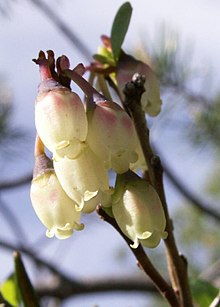Vaccinium uliginosum
| Vaccinium uliginosum | |
|---|---|

| |
| Leaves and fruit | |
| Scientific classification | |
| Kingdom: | |
| (unranked): | |
| (unranked): | |
| (unranked): | |
| Order: | |
| Family: | |
| Genus: | |
| Species: | V. uliginosum
|
| Binomial name | |
| Vaccinium uliginosum L. 1753
| |
| Synonyms[1] | |
|
Synonymy
| |
Vaccinium uliginosum (bog bilberry, bog blueberry,[2] northern bilberry or western blueberry[3]) is a Eurasian and North American flowering plant in the genus Vaccinium within the heath family.


Distribution
Vaccinium uliginosum is native to cool temperate regions of the Northern Hemisphere, at low altitudes in the Arctic, and at high altitudes south to the Pyrenees, the Alps, and the Caucasus in Europe, the mountains of Mongolia, northern China, the Korean Peninsula and central Japan in Asia, and the Sierra Nevada in California and the Rocky Mountains in Utah in North America.[4][5][6][7]
It grows on wet acidic soils on heathland, moorland, tundra, and in the understory of coniferous forests, from sea level in the Arctic, up to 3,400 metres (11,200 ft) altitude in the south of the range.
Description
Vaccinium uliginosum is a small deciduous shrub growing to cm 10–75 centimetres (0.33–2.46 ft) tall, rarely 1 metre (3.3 ft) tall, with brown stems (unlike the green stems of the closely related Bilberry). The leaves are oval, 4–30 millimetres (0.16–1.18 in) long and 2–15 millimetres (0.079–0.591 in) wide, blue-green with pale net-like veins, with a smooth margin and rounded apex.[4]
The flowers are pendulous, urn-shaped, pale pink, 4–6 mm long, produced in mid spring. The fruit is a dark blue-black berry 5–8 millimetres (0.20–0.31 in) diameter, with a white flesh, edible and sweet when ripe in late summer.[4]
Subspecies
Some authors separate them, but these are not considered distinct by all authorities - the subspecies are:
- Vaccinium uliginosum subsp. microphyllum - Arctic plants [8]
- Vaccinium uliginosum subsp. occidentale - North American plants [9]
- Vaccinium uliginosum subsp. uliginosum
References
- ^ The Plant List, Vaccinium uliginosum L.
- ^ NRCS. "Vaccinium uliginosum". PLANTS Database. United States Department of Agriculture (USDA). Retrieved 28 July 2015.
- ^ Jepson Flora Project, University of California: Vaccinium uliginosum
- ^ a b c Flora of North America, Vaccinium uliginosum Linnaeus, 1753. Bog bilberry, airelle des marécages
- ^ Flora of China, Vaccinium uliginosum Linnaeus, 1753. 笃斯越桔 du si yue ju
- ^ Altervista Flora Italiana, Falso mirtillo, Vaccinium uliginosum L.
- ^ Biota of North America Program 2014 state-level distribution map
- ^ Lange
- ^ (A.Gray) Hultén
Further reading
- Blamey, M., & Grey-Wilson, C. (1989). Flora of Britain and Northern Europe. Hodder & Stoughton.
External links
- Linnaeus−Den virtuelle floran — Distribution of Vaccinium uliginosum
- USDA Plants Profile for Vaccinium uliginosum (bog blueberry)
- Calflora Database: Vaccinium uliginosum (Western blueberry)
- Jepson Manual treatment of Vaccinium uliginosum — flora of California.
- "Vaccinium uliginosum". Plantarium (in Russian).
- USDA GRIN−Germplasm Resources Information Network: Vaccinium uliginosum
- Flora Europaea: Vaccinium uliginosum
- Plants of British Columbia: Vaccinium uliginosum
- Vaccinium uliginosum in the CalPhotos photo database, University of California, Berkeley
- Vaccinium
- Berries
- Alpine flora
- Arctic flora
- Flora of the Alps
- Flora of Europe
- Flora of temperate Asia
- Flora of Canada
- Flora of Greenland
- Flora of the Northeastern United States
- Flora of the Western United States
- Flora of the Sierra Nevada (U.S.)
- Bird food plants
- Japanese fruit
- Plants described in 1753
- Taxa named by Carl Linnaeus
